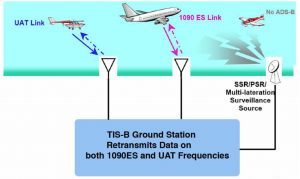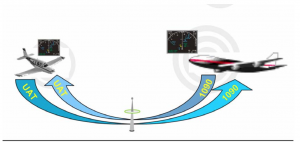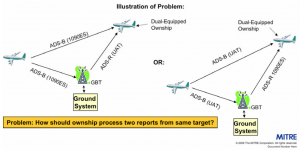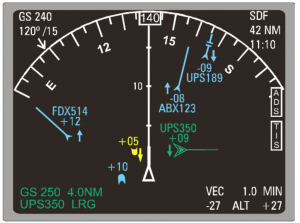48TH ANNUAL CONFERENCE, Dubrovnik, Croatia, 20-24 April 2009WP No. 87Surveillance – Investigate the Use of Re-Transmitted Data to Aircraft (ADS-R and TIS-B)Presented by TOC |
Summary
The United States of America (USA) is planning to use two different frequencies for Automatic Dependent Surveillance-Broadcast (ADS-B); 1090 Extended Squitter (ES) for air carriers and business jets, and Universal Access Transceiver (UAT, 978 MHz) for general aviation aircraft. Automatic Dependent Service Rebroadcast (ADS-R) is a method that will be used to rebroadcast ADS-B information received on the different frequencies to the other, which allows different equipped aircraft to see each other. Additionally, the use of Traffic Information Service Broadcast (TIS-B) will provide traffic information on non-participating ADS-B aircraft by broadcasting surveillance information received via other sources on both 1090 and UAT frequencies. This paper is information material.
Introduction
1.1 This paper will take a high level look at two developing Automatic Dependent Surveillance – Broadcast (ADS-B) technologies. Automatic Dependent Service Rebroadcast (ADS-R)- a method used to rebroadcast ADS-B information received on two different frequencies which allows different equipped aircraft to see each other, and Traffic Information Service Broadcast (TIS-B)- a system for broadcasting traffic information received by other surveillance sources on non-ADS-B participating traffic. Although parts of the equipment and software used for ADS-R and TIS-B are available today, a majority of the equipment and concepts that are reviewed in this paper are conceptual in nature.
1.2 Currently, the United States of America (USA) is the only country that plans to use ADS-R technology and as such the majority of the information presented will come from sources that are ongoing within the industry and the Federal Aviation Administration (FAA).
1.3 Early into the development of ADS-B, it was determined that due to the volume of aircraft operating within USA airspace at any one time, there would be a serious issue of frequency congestion on the 1090 MHz band. Congestion on the 1090 MHz frequency occurs because of the sharing of that frequency by four major aviation systems: ADS-B 1090 Extended Squitter (1090 ES), the Traffic Collision Avoidance System (TCAS), Airport Surface Detection Equipment (ASDE) and Secondary Surveillance Radar (SSR). Additionally in the early 1990’s when the potential of ADS-B for General Aviation (GA) became recognized, private aircraft owners in the US disapproved at the cost and the size of the heavy airline units. As a result, the FAA funded the development of the Universal Access Transceiver (UAT), a smaller, lighter, and more capable unit that operated on the 978 MHz band. It seemed logical that by having the majority of general aviation using UAT would alleviate some of the frequency spectrum issues. Unfortunately, the outcome of this decision is that 1090 ES- equipped aircraft would be able to “see” all other 1090 ES equipped aircraft, but not UAT- equipped aircraft, and vice versa.
1.4 In order to solve this problem, the USA plans to use ADS-R to rebroadcast information received on each frequency to the other thus allowing different equipped aircraft to see each other.
Discussion
2.1 ADS-B
2.1.1 ADS-B is an advanced surveillance technology that provides highly accurate and comprehensive surveillance information via a broadcast communication link. ADS-B transmits flight data derived from on-board position-fixing and navigational systems. Aircraft determine their position (longitude, latitude, altitude, and time) using Global Positioning System (GPS), internal navigational reference system, or otherwise. The aircraft’s ADS-B equipment processes this information, along with other aircraft-derived flight parameters, into a periodic broadcast transmission, typically once a second. Any airborne or ground-based ADS-B capable receiver, within range of broadcast, may receive and process the surveillance information for a variety of functions or uses.
2.2 UAT – Universal Access Transceiver
2.2.1 UAT is an ADS-B protocol, which operates on 978 MHz. This slice of the electro- magnetic spectrum has been allocated to ADS-B domestically in the USA, but not internationally as some non-USA Distance Measuring Equipment (DME) stations use it. The FAA has used the UAT protocol successfully for the Capstone ADS-B trials in Alaska. Like the 1090 ES protocol, UAT equipment is capable of receiving TIS-B traffic information from ground stations and because of larger bandwidth availability on 978 MHz versus 1090 MHz, UAT equipment can also receive high bandwidth graphical data from ground stations. The ground to air data uplink can operate at speeds up to 100 kbps.
2.2.2 UAT was chosen for GA aircraft that operate at lower altitudes in order to reduce the 1090 MHz frequency congestion and because of the 17% lower costs found in the 2001 Safe Flight 21 analysis. UAT also has the bandwidth for broadcast flight information service data. This type of data would include, but is not limited to, national, regional and local weather data, terminal information, Notice to Airmen (NOTAM), Runway Visual Range (RVR), Special Use Airspace (SUA) status, and auxiliary data. UAT also has the ability to support long-range reception (greater than 120 Nautical Miles (NM)) in the dense traffic environment.
2.3 1090 ES
2.3.1 The 1090ES link is the internationally agreed link for ADS-B, and is intended to support applications for air carriers and other high-performance aircraft. The 1090ES broadcast link does not support other data applications that are available, such as weather and related flight information due to bandwidth limitations. Other commercial products generally provide that type of weather and flight information for 1090ES-equipped aircraft.
2.4 1090ES Spectrum Limitations
2.4.1 Spectrum performance issues on the 1090 MHz frequency are a concern as they are shared by ADS–B (1090ES), TCAS, and SSR. For example, as ADS–B equipage expands, the majority of the technical community is of the view (even though there is planned reductions in the number of surveillance radar systems) that the interference environment in the Northeast corridor of the USA in 2020 will most likely limit the ADS– B In (ADS-B In refers to the ability of the aircraft to receive ADS-B (as well as TIS-B) information from other aircraft and ground stations and display it on a cockpit display. This information can include trajectory and velocity vectors and has a greater range than TCAS) )air-to-air range to less than 40 NM (and according to some experts, perhaps as little as 20 to 25 NM). Without further reductions in the use of 1090 MHz by TCAS and/or SSR, the situation will deteriorate further in the 2020–2035 time frame as air traffic growth is expected to continue.
2.4.2 ADS–B Minimum Aviation System Performance Standards (MASPS, specifies characteristics that should be useful to designers, installers, manufacturers, service providers and users of systems intended for operational use within a defined airspace) such as sequencing and merging, conflict management, and long range conflict management, have been specified as requiring a 40 NM or greater range and would therefore be unavailable to airspace users of 1090 ES ADS–B, without further mitigations of 1090 MHz by TCAS and/or SSR.
2.4.3 The 1090 ES situation is further complicated by desires within the user community to add message elements to the ADS–B data set (for example, intent information) to support more advanced air-to-air ADS–B applications. Because of international concern about 1090 MHz frequency saturation in high density airspace and the protection of TCAS and SSR, ICAO has put a hard limit on the number of ADS–B messages that can be broadcast on 1090 MHz by a single aircraft (ICAO Annex 10 Aeronautical Telecommunications, Volume IV, Section 3.1.2.8.6.4). Therefore, additional ADS–B message elements for air-to-air applications will be limited without a fundamental change to the 1090 ES ICAO Standards and Recommended Practices (SARPs) and potential further impact on spectrum congestion.
2.4.4 The FAA ADS-B workgroup has further confirmed the findings of the 2001 FAA/ EUROCONTROL Technical Link Assessment Team (TLAT, was a joint venture between the Federal Aviation Administration (FAA) and Eurocontrol. This group was charged with providing continued technical evaluation of three ADS-B and situational awareness link candidates: 1090 MHz Extended Squitter (1090ES), VHF Digital Link (VDL) Mode 4, and Universal Access Transceiver (UAT)) that these air-to-air ADS-B In performance issues in high-density airspace are not an issue for UAT-based ADS– B, at least for the applications identified in the Radio Technical Commission for Aeronautics (RTCA) ADS–B MASPS. Therefore, the FAA envisages UAT as being available in 2020–2035 for any air-to-air ADS–B In applications that cannot be supported in high-density airspace by 1090 ES.
2.5 ADS-R
2.5.1 ADS-R is the method used to rebroadcast information received on both UAT and 1090ES, thus allowing different equipped aircraft to observe traffic on their Cockpit Display of Traffic Information (CDTI). This capability will only be available in regions of ground station coverage. Currently the FAA plans to only have this type of capability in the busy terminal areas. Unless the FAA intends to put ADS-R at every FAA certified airport in the country, there will be significant areas where 1090ES airplanes will not see UAT airplanes and vice versa. This will eliminate the ability to perform air-to-air separation applications without working ground stations until such time that all aircraft are equipped with ADS-B.
2.5.2 ADS-R technology in itself will not directly affect air traffic controllers since the technology only increases the pilot’s situational awareness by displaying data in the cockpit.
2.6 Traffic Information Service Broadcast-TIS-B
2.6.1 As an interim step in the deployment of ADS-B, the FAA will also use a system for broadcasting traffic information on non-ADS-B traffic obtained from surveillance radar or other systems and broadcast that information on both 1090ES and UAT frequencies. This system is known as Traffic Information Service Broadcast (TIS-B).
2.6.2 TIS-B is a ground-based uplink report to a pilot of proximate traffic that is under surveillance by Air Traffic Control (ATC) but is not ADS-B equipped. This service would be available even with limited ADS-B implementation. The combinations of the surveillance and TIS-B services will enable pilots to have enhanced visual acquisition of other non ADS-B aircraft that they otherwise would not be aware of. Having traffic and other flight obstacles on a cockpit display will enable pilots to more quickly identify safety hazards and communicate with ATC if necessary. Aircraft that are equipped with ADS-B can be monitored through a direct reception of their ADS-B signals in an air-to- air environment. TIS-B will provide this comprehensive air traffic situational awareness until all aircraft are equipped with ADS-B Out, at which time TIS-B will be decommissioned.
2.6.3 For ADS-B aircraft to see non-ADS-B aircraft, the FAA plans to build a network of ground transmitters (TIS-B stations) that receive surveillance from existing radars. These TIS-B ground installations detect the non-ADS-B-aircraft, convert the surveillance data to ADS-B format and transmit the data.
2.6.4 The ground-based TIS-B application broadcasts the SSR picture for the airspace. Surveillance data may be combined from primary and secondary radars, satellite-based ADS, ADS-B and other assets (e.g. surface surveillance radar for surface operations).

Figure 1: TIS-B transmitting data on non-ADS-B aircraft to 1090 and UAT aircraft
2.6.5 The TIS-B messages will look like ADS-B messages to equipped aircraft. The Ground Based System (GBS) will act as a protocol translator for converting the various ground surveillance formats/protocol. The GBS TIS-B function will act as a gap-filler for showing non-ADS-B equipped targets to ADS-B equipped aircraft until total ASD-B equipage has been achieved. This data will be provided on the airport surface as well as terminal domain.
2.6.6 As with ADS-R, TIS-B will not directly affect air traffic controllers since the technology only increases the pilot’s situational awareness by displaying data in the cockpit.
2.7 Ground Based System
2.7.1 The main purpose of the GBS is to act as a TIS-B uplink to aircraft equipped with 1090 and UAT avionics that can receive TIS-B messages. The GBS accepts target reports from the terminal fusion server (see 2.9) and provide them to other systems. The GBS can accept and process up to 255 target reports per second.
2.7.2 The Ground Based Transmitters (GBTs) are dual-frequency units which, upon receiving an airliner’s 1090ES squitt, will immediately “translate” them into UAT formats and broadcast them back up on the UAT frequency, thereby making the airliner “visible” to UAT aircraft in the vicinity. Conversely, when UAT signals are received by the GBTs, they will perform a reverse translation process and retransmit these in 1090ES format and frequency. ADS-B reports received in the GBS from the UAT GBTs will be routed to the 1090 transmitter. Any information received by TIS-B that is associated with an already ADS-B identified aircraft will be filtered and kept from being sent to the 1090 transmitter.

Figure 2: GBT re-transmitting signals to other frequency
2.7.3 The GBT transmits up to 100 extended squitters per second, evenly spaced at 10 millisecond intervals. Safeguards are provided to assure that a minimum interval of 8 milliseconds is maintained between consecutive transmissions of extended squitters (to protect against a ‘stuck mike’).
2.7.4 Preliminary estimates by the FAA call for 548 of these ground stations to provide coverage nationwide as well as in the Gulf of Mexico.
2.8 Masking beacon codes
2.8.1 In the USA, FAA Order 1200.22B requires that tracks containing sensitive and/or controlled national defence or law enforcement data must have identifiers removed or replaced with 1200 equivalent codes before sending to the GBTs. The initial plan for this functionality is to use a list of restricted beacon codes or ranges and to filter based on a lookup table or case statement technique. The sensitive beacon codes can either be left blank or substituted with an arbitrary or 1200 code.
2.9 Fusion
2.9.1 In order to take into account all ADS-B and TIS-B sources, the fusion processor fuses the data from the various radar sources and ADS-B stations to create a unified, and accurate surveillance picture. ADS-B data can be used to increase coverage when radars do not cover some areas. ADS-B also complements the coverage for areas already covered by radar.
Fused system tracks provide:
- single system track for all sensors
- fusion of all relevant down linked data
- more accurate tracking
2.10 Latency
2.10.1 Because the data from either a 1090ES or UAS aircraft must be received by the ground station and then retransmitted so that the different equipped aircraft can see each other, that delay or “latency” in the signal causes some concern and if it is not mitigated could affect the application of future concepts such as 4-D Trajectory management.
2.10.2 The same latency issues associated with ADS-R apply to TIS-B as well.
2.10.3 With this multilink system, there are 3 sources of latency:
- First, there is the time to process and broadcast the GPS position. This latency is required to be less than 1 second for initial aircraft surveillance applications.
- The second source of latency is the GBT processing of the position report then rebroadcast the position on the other link.
- The third source of latency is the receiving aircraft’s processing and display. With a single link the second source of latency is removed.
2.10.4 To mitigate against the latency problem, each ADS-B message contains a time of applicability, with the time in Universal Co-ordinated Time (UTC) in which the GPS measurement occurred. Consumers of the ADS-B data can use this time to disregard late reports or account for the latency.
2.11 Compensation for latency
2.11.1 In order to compensate for latency of the signal, the ground station will adjust for the delay and retransmit the signal with an appropriate time stamp.
2.11.2 The dual link will also add latency to the system, possibly preventing dual link ADS-B to be used for conflict avoidance or even CDTI situational awareness since the data would be stale. Because of this latency, IFALPA currently opposes the use of any redirect data for use in TCAS capacity (Although there is currently discussion as to whether or not TCAS/ACAS will be replaced by an ADS-B related software algorithm, it is outside the scope of this paper).
2.12 Dual-Equipped
2.12.1 Aircraft that choose to equip with both 1090ES and UAT will have the ability to receive data from both sources. The aircraft’s avionics will have to determine how to handle the issue of receiving data on a single aircraft via two sources. Since dual equipped aircraft can receive both ADS-B (direct) and ADS-R (rebroadcast) reports on the same target, there must be a method to determine which data it should use.
2.12.2 There are two concepts currently under discussion:
- Fusion of both ADS-B and ADS-R reports where the ADS-B source only becomes primary when ADS-R reception has ceased for a fixed amount of time; and
- ADS-B used as the primary source and acceptance of ADS-R for track update only when ADS-B reception has ceased for a fixed amount of time.

Figure 3: Dual-Equipped Aircraft receiving information from both ADS-B and ADS-R 2.13 ADS-R Coverage
2.13.1 Currently a major issue in the USA is the inability for a pilot to determine its location within the defined ADS-R coverage area. The industry and the FAA are currently discussing ways to transmit coverage area to the aircraft.
2.14 Cockpit Display of Traffic Information (CDTI)
2.14.1 The CDTI will give the pilot a “Radar-like” display that shows ADS-B equipped traffic (airborne and ground equipment), as well as TIS-B traffic. In the diagram below, the ADS-B aircraft have the call signs displayed, while the TIS-B traffic just shows the target along with altitude information.

Figure 4: CDTI displaying ADS-B aircraft and traffic information provided by TIS-B 2.15 Equipage cost
2.15.1 Air transport aircraft (1090 ES)
Average unit costs for ADS-B Out range from US$32,000 to US$174,000 per aircraft. FAA estimates the incremental costs for ADS-B In (depending on display requirements) to range from US$162,000 to US$670,000 per aircraft.
2.15.2 GA (UAT technology)
Average unit costs for ADS-B Out range from US$7,600 to US$10,900 per aircraft. FAA estimates the average cost for ADS-B In and Out to range from US$10,444 to US$29,700, depending on the aircraft type.
2.16 USA planned implementation schedule
2006-2009
ADS-B deployment and voluntary equipage, along with rule making activities. Pockets of development will exploit equipment deployment in the areas that will provide proof of concept for integration to ATC automation systems deployed in the NAS
2010-2014
ADS-B ground stations will be deployed throughout the NAS, with an In- Service Decision due in the 2012-13 time frame. Completed deployment will occur in the 2013-2014 time frame. Equipage is expected to begin after the proposed rule is finalized in around 2010.
2015-2020
Limited radar decommissioning will begin in the time frame with an ultimate goal of a 50% reduction in the Secondary Surveillance Radar infrastructure.
2025
Complete removal of targeted TIS-B services and decommission after all aircraft are ADS-B equipped.
Conclusions
3.1 Although there is much debate in the aviation community as to the frequency congestion in the 1090 spectrum, the major concern is the expected future air traffic growth. Since the FAA’s NextGen plan is based on Air-to-Ground and Air-to-Air ADS-B data capable of being received in time to negotiate 4-D Trajectory contracts, the FAA has chosen to mitigate the frequency congestion concern by using two different frequencies.
3.2 Although the ADS-R and TIS-B concept in its current design does not appear to have a direct impact on air traffic controllers, it is important that IFATCA continues to monitor these developing technologies to ensure that no new requirements on controllers are introduced without proper review and comment.
Recommendations
It is recommended that;
4.1 This paper is accepted as information material.
References
DEPARTMENT OF TRANSPORTATION Federal Aviation Administration 14 CFR Part 91 [Docket No. FAA-2007-29305; Notice No. 07-15] RIN 2120-AI92.
Automatic Dependent Surveillance – Broadcast (ADS-B) Out performance requirements to support Air Traffic Control (ATC) service.
Briefing to ICNS Conference, Fairfax, VA Rob Strain 3 May 2005 CAASD MITRE.
Challenges Facing the Implementation of FAA’s Automatic Dependent Surveillance – Broadcast Program; U.S. Department of Transportation October 17, 2007 CC-2007-100.
RTCA, Minimum Aviation System Performance Standards For Automatic Dependent Surveillance Broadcast (ADS-B), RTCA/DO-242A, June 2002.
Radar / ADS-B data fusion architecture for experimentation purpose. THALES.
Benefits and Incentives for ADS-B Equipage in the National Airspace System: Edward A. Lester and R. John Hansman Report No. ICAT-2007-2 August 2007 Massachusetts Institute of Technology.
1090-WP-7-07; 17 October 2001 RTCA Special Committee 186, Working Group 3.
ADS-B 1090 MOPS, Revision A Appendix for Ground Processing for TIS-B and FIS-B.
Initial Thoughts on Dual Link Reception of ADS-B MITRE/CAASD Roxaneh Chamlou Oct 2006.
FAA ADS-B Status Briefing: ASAS TN2; Vincent Capezzuto April 14, 2008.


